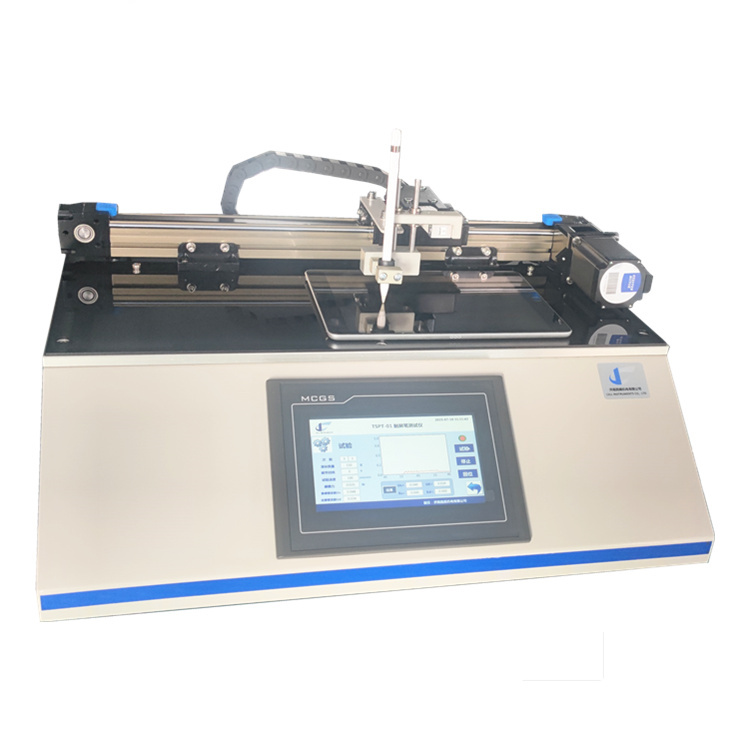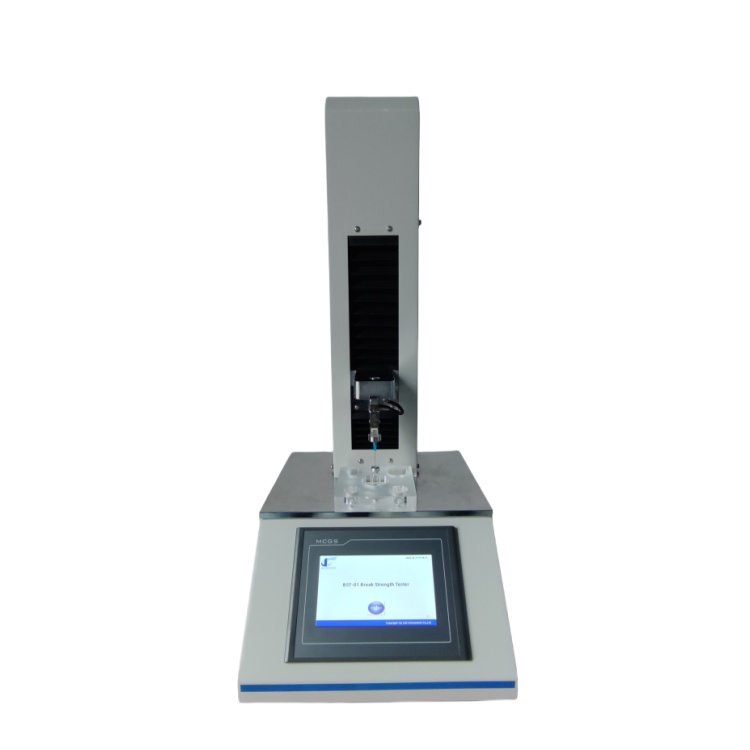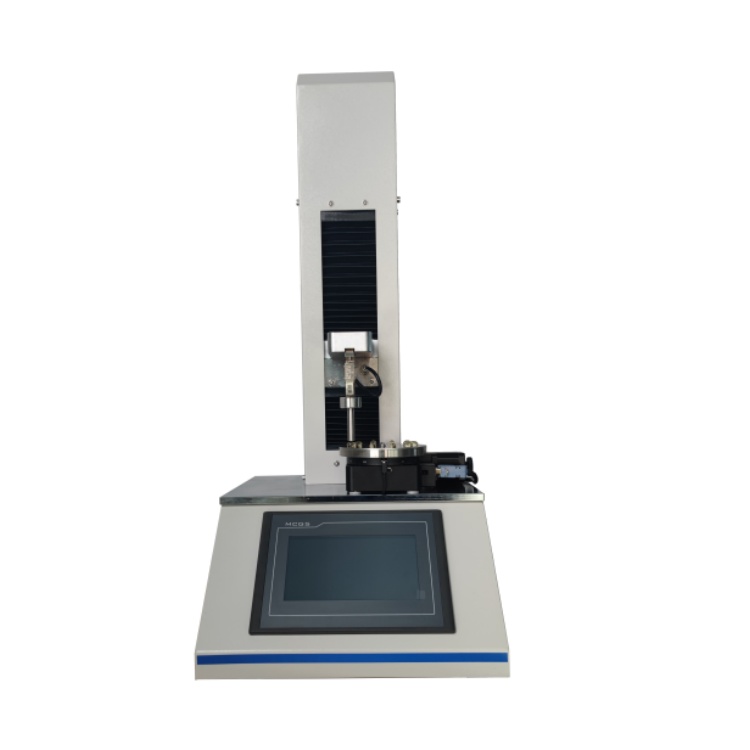TSTP-01 Stylus Pen Sliding and Ceofficient of Friction Tester
The emergence of stylus pens aims to enhance the interactive experience of touchscreen devices by providing a more accurate, natural, and feature-rich input method to meet people's needs in various application scenarios. Whether it's drawing, writing, precise selection, or multi-functional operations, stylus pens offer users more possibilities and convenience.
The writing resistance and friction coefficient between the stylus and the screen are important factors that influence the writing experience.
Writing resistance refers to the perceived resistance or friction when using a stylus to write on the screen. This resistance is generated by the friction between the stylus tip and the screen surface. Different stylus pens and screen surface materials may result in different levels of writing resistance. Some people prefer higher writing resistance as it provides a feeling closer to writing on paper, while others prefer lower writing resistance for a smoother writing experience. Choosing the appropriate writing resistance depends on personal preference.
The friction coefficient is a parameter that represents the magnitude of friction between two objects. In the case of a stylus, the friction coefficient refers to the friction between the stylus tip and the screen surface. The level of friction coefficient affects the sliding and writing experience of the stylus on the screen. A higher friction coefficient means more resistance and friction, which may make it relatively difficult for the stylus tip to slide on the screen during writing. On the other hand, a lower friction coefficient reduces resistance and friction, resulting in a smoother writing process.
TSTP-01 Stylus Pen Sliding and Ceofficient of Friction Tester places the stylus pen vertically and applies a certain weight to it. The sample touchscreen is placed on the tester platform within the range of stylus pen movement. For the reciprocating friction test, the number of reciprocations and the speed are set, and the test can be started accordingly. For the friction coefficient test, the required parameters such as applied weight and speed are input as per the specifications, and then the test can be initiated.
TSTP-01 Stylus Pen Sliding and Ceofficient of Friction Tester is controlled by a PLC (Programmable Logic Controller) and features an HMI (Human-Machine Interface) for user-friendly operation. It is designed for industrial-grade stability and reliability. The device offers high precision in displacement control, with customizable speeds of up to 12,000mm/min.
The parameters can be intuitively input, and the testing process is automated, including data recording and statistical analysis. The device serves as an essential instrument for stylus manufacturers and related laboratories.
The screen of the device is designed for multilingual display, catering to the needs of users both domestically and internationally.

| Item | Parameters |
| Force Range | 5N |
| Resolution | 0.5% FS |
| Speed | 1~12000mm/min |
| Accuracy | 0.1mm/min |
| Loading Weight | 150g(can be customized) |
| Stroke | 350mm(can be customized) |
| Control | PLC and HMI Touch Screen |
| Power | 110~220V |
In addition to sliding and friction coefficient testing for stylus pens, the TSTP-01 stylus tester can also be used for friction coefficient testing, high-speed peel testing, and reciprocating friction testing of other materials.
For friction coefficient testing of other materials, you can use the TSTP-01 stylus tester to evaluate the friction performance between different materials. By setting appropriate testing parameters such as loading weight, speed range, and speed accuracy, you can simulate friction under different conditions and measure and compare the friction coefficients.
High-speed peel testing is a method to evaluate the performance of materials during the peeling process. Using the TSTP-01 stylus tester, you can set suitable testing parameters such as peel speed and loading weight to simulate high-speed peeling processes. This testing can be used to study properties such as adhesion and peel strength of materials.
Reciprocating friction testing is a method to assess the wear resistance of materials during reciprocating friction. With the TSTP-01 testing device, you can set the number of reciprocations, speed, and loading weight to simulate different friction conditions. This can be used to evaluate characteristics such as wear resistance and frictional loss of materials.
-
ꄶ By Tester Name
-
Leak Tester
-
Pressure Decay/Burst Tester
-
Micro Leak Tester
-
Gross Leak Tester
-
Tensile Tester
-
Heat Seal Tester
-
Coefficient of Friction Tester
-
Falling Dart Impact Tester
-
Falling Ball Impact Tester
-
Pendulum Impact Tester
-
Hot Tack Tester
-
Shrink Tester
-
Cling Peel Force Tester
-
Thickness Tester
-
Flex Durability Tester
-
Elmendorf Tear Tester
-
Peel Test Stand
-
Test Stand
-
Impact Tester
-
Carbonation Tester
-
Torque Tester
-
Bottle Tester
-
Lid Film Peeling Tester
-
Box Compression Tester/BCT Tester
-
Ink Rub Tester
-
Mullen Bursting Tester
-
Plybond Tester
-
Stiffness Tester
-
Folding Endurance Tester
-
Beating Freeness Tester
-
COBB Tester
-
Concora Medium Fluter
-
Puncture Tester
-
Crush Tester
-
Ink Rub Tester
-
Paper Core Compression Tester
-
Paper Dirt Tester
-
Board Thickness Tester
-
Paper Thickness Tester
-
Softness Tester
-
Short Span Compression Tester
-
Paper Tear Tester
-
Smoothness Tester
-
Air Permeance Tester
-
Paper Tensile Tester
-
Valley Beater
-
Bending Stiffness Tester
-
Taber Stiffness Tester
-
Ampoule Breaking Tester
-
Softgel Hardness Tester
-
Pharm and Medical Packaging Tester
-
Glass Grain Sampling Machine
-
Cap Opening Force Tester
-
Medical Syringe Tester
-
Puncture Tester
-
Drawing Volume Tester
-
Tablet Hardness Tester
-
Motorized Torque Tester
-
Package Compression Tester
-
Verticality Tester
-
Bottle Thickness Tester
-
Top Load Tester
-
Vibration Test Machine
-
Ball Tack Tester
-
High Speed Unwinding Force Tester
-
Loop Tack Tester
-
Tape Shear Adhesion Tester
-
Cleaning Efficacy Tester
-
Mop Cloth Coefficient of Friction Tester
-
Hot Air Thermal Shrinkage Tester
-
Mop Friction Force Tester
-
Charpy and lzod lmpact Tester
-
Melt Flow Rate Tester
-
Stylus Pen Sliding and COF Tester
-
Pendulum Hammer Striking Tester
-
Texture Analyzer
-
Gel Strength Tester
-
Tensile Tester
-
-
ꄶ By Test Type
-
ꄶ By Test Material
-
ꄶ By Industry
-
ꄶ By Test Standard
-
ꁇ GB Standard
-
GB 8808
-
GB 7000.1
-
GB 10006
-
GB 15171
-
GB/T 10792
-
GB/T 1040
-
GB/T 9639
-
GB/T 8809
-
GB/T 13519
-
GB/T 6672
-
GB/T 451
-
GB/T 6547
-
GB/T 10440
-
GB/T 18454
-
GB/T 19741
-
GB/T 17447
-
GB/T 17876
-
GB/T 10004
-
GB/T 40266
-
GB/T 2637
-
GB/T 12416.2
-
GB/T 6582
-
GB/T 15267
-
GB/T 16578.2
-
GB/T 55
-
GB/T 2423
-
GB/T 20138
-
GB/T17876
-
GB/T 8942
-
GB/T 2679.10
-
GB/T12914
-
GB/T 24328.3
-
GB/T 24328.4
-
GB/T 24328.5
-
GB/T24325
-
GB/T 2679.3
-
GB/T 22364
-
GB/T 2679.8
-
GB/T 6546
-
GB/T 6548
-
GB/T 22874
-
GB 2679.6
-
GB/T 4857.3
-
GB/T 4857.4
-
GB 4857.7
-
GB/T 4852
-
GT/T 4851
-
GB/T 3682.1
-
GB/T 3682.2
-
GB/T18742
-
-
ꁇ ISO Standard
-
ISO 8295
-
ISO 11607
-
ISO 7765
-
ISO 4593
-
ISO 3034
-
ISO 534
-
ISO 719 ISO 720
-
ISO 12625
-
ISO 6383
-
ISO 1974
-
ISO 16260
-
ISO 9895
-
ISO 1924-1
-
ISO 1924-2
-
ISO 1924-3
-
ISO 12625-4
-
ISO 12625-5
-
ISO 5264
-
ISO 2493-2
-
ISO 12192
-
ISO 3037
-
ISO 3035
-
ISO 16945
-
ISO 2234
-
ISO 12048
-
ISO 2874
-
ISO 2872
-
ISO 8113
-
ISO 2247
-
ISO 1133-2
-
ISO 1133-1
-
ISO 8510-2
-
ISO 14616
-
ISO 37
-
-
ꁇ ASTM Standard
-
ASTM D202
-
ASTM D882
-
ASTM D3078
-
ASTM D4918
-
ASTM F1140
-
ASTM F2029
-
ASTM F2054
-
ASTM D1709
-
ASTM D3420
-
ASTM D2732
-
ASTM D374
-
ASTM D1777
-
ASTM F392
-
ASTM D 2063
-
ASTM D3198
-
ASTM D3474
-
ASTM D5264
-
ASTM D5458
-
ASTM D1894
-
ASTM F2338
-
ASTM D1424
-
ASTM D689
-
ASTM F2096
-
ASTM 0000
-
ASTM D2923
-
ASTM D6828
-
ASTM D5342
-
ASTM D5650
-
ASTM D3301
-
ISO 7263-1
-
ASTM D642
-
ASTM D4169
-
ASTM D2659
-
ASTM D4577
-
ASTM D999
-
ASTM D3121
-
ASTM D1000
-
ASTM D3654
-
ASTM D1238
-
ASTM D4917
-
ASTM D3330
-
ASTM F1921
-
ASTM D1922
-
ASTM D638
-
ASTM E4
-
ASTM F904
-
ASTM F88
-
ASTM D1938
-
-
ꁇ YBB Standard
-
ꁇ QB/T Standard
-
ꁇ YY/T Standard
-
ꁇ BB Standard
-
ꁇ TAPPI Standard
-
ꁇ IEC Standard
-
ꁇ JIS Standard
-
ꁇ EN DIN Standard
-
ꁇ PSTC Standard
-
FINAT Standard
-
ꁇ BS Standard
-
ꁇ NF Standard
-






















